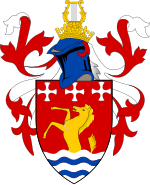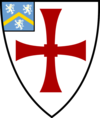
Lincoln College is one of the constituent colleges of the University of Oxford, situated on Turl Street in central Oxford. Lincoln was founded in 1427 by Richard Fleming, the then bishop of Lincoln.
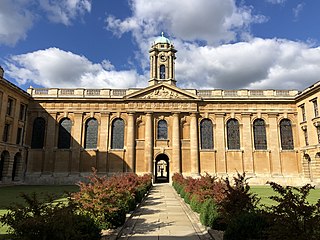
The Queen's College is a constituent college of the University of Oxford, England. The college was founded in 1341 by Robert de Eglesfield in honour of Philippa of Hainault, queen of England. It is distinguished by its predominantly neoclassical architecture, primarily dating from the 18th century.

Regent's Park College is a permanent private hall of the University of Oxford, situated in central Oxford, just off St Giles', England, United Kingdom.
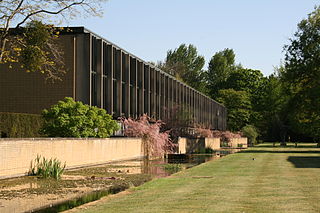
St Catherine's College is one of the constituent colleges of the University of Oxford. In 1974, it was also one of the first men's colleges to admit women. It has 528 undergraduate students, 385 graduate students and 37 visiting students as of December 2020, making it one of the largest colleges in either Oxford or Cambridge.

Selwyn College, Cambridge is a constituent college of the University of Cambridge. The college was founded in 1882 by the Selwyn Memorial Committee in memory of George Augustus Selwyn (1809–1878), the first Bishop of New Zealand (1841–1868), and subsequently Bishop of Lichfield (1868–1878). Its main buildings consist of three courts built of stone and brick. There are several secondary buildings, including adjacent townhouses and lodges serving as student hostels on Grange Road, West Road and Sidgwick Avenue. The college has some 60 fellows and 110 non-academic staff.
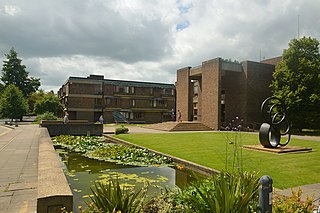
Churchill College is a constituent college of the University of Cambridge in Cambridge, England. It has a primary focus on science, engineering and technology, but retains a strong interest in the arts and humanities.

University College, informally known as Castle, is the oldest constituent college of the University of Durham in England. Centred on Durham Castle on Palace Green, it was founded in 1832 by William van Mildert, Bishop of Durham. As a constituent college of Durham University, it is listed as a higher education institution under section 216 of the Education Reform Act 1988. Almost all academic activities, such as research and tutoring, occur at a university level.

Collingwood College is a college of Durham University in England. It is the largest of Durham's undergraduate colleges with around 1800 students. Founded in 1972 as the first purpose-built, mixed-sex college in Durham, it is named after the mathematician Sir Edward Collingwood (1900–1970), who was a former Chair of the Council of Durham University.
Durham Students' Union, operating as Durham SU, is the students' union of Durham University in Durham, England. It is an organisation, originally set up as the Durham Colleges Students’ Representative Council in 1899 and renamed in 1969, with the intention of representing and providing welfare and services for the students of the University of Durham.

Grey College is a college of Durham University in England, founded in 1959 as part of the university's expansion of its student population. The college was originally planned to be named Oliver Cromwell College, but this proved too controversial. Instead, the college is named after Charles Grey, 2nd Earl Grey, who was Prime Minister of the United Kingdom at the time of the university's foundation.

Hatfield College is one of the constituent colleges of Durham University in England. It occupies a city centre site above the River Wear on the World Heritage Site peninsula, lying adjacent to North Bailey and only a short distance from Durham Cathedral. Taking its name from a medieval Prince-Bishop of Durham, the college was founded in 1846 as Bishop Hatfield's Hall by David Melville, a former Oxford don.

St Aidan's College is a college of the University of Durham in England. It had its origins in 1895 as the association of women home students, formalised in 1947 as St Aidan's Society. In 1961, it became a full college of the university, and in 1964 moved to new modernist buildings on Elvet Hill designed by Sir Basil Spence.

St Mary's College is a college of Durham University in England. Following the grant of a supplemental charter in 1895 allowing women to receive degrees of the university, St Mary's was founded as the Women's Hostel in 1899, adopting its present name in May 1920.

Ustinov College is the largest college of Durham University, located in Durham, North East England. Founded as the Graduate Society in 1965, it became a college in 2003 and was named after then-chancellor, Sir Peter Ustinov. Formerly at the Howlands Farm site at the top of Elvet Hill, in 2017 the college relocated to the Sheraton Park site in Neville's Cross.

Van Mildert College is a college of Durham University in England. Founded in 1965, it takes its name from William Van Mildert, Prince-Bishop of Durham from 1826 to 1836 and a leading figure in the University's 1832 foundation. Originally an all-male college, it became co-educational in 1972 with the admission of female undergraduates.

John Snow College is a constituent college of Durham University. The college was founded in 2001 on the University's Queen's Campus in Stockton-on-Tees, before moving to Durham in 2018. The College takes its name from the nineteenth-century Yorkshire physician John Snow, one of the founders of modern epidemiology.

Josephine Butler College is a constituent college of Durham University. The college was opened in 2006. It is named after Josephine Elizabeth Butler, a 19th-century feminist and social reformer who had a significant role in improving women's public health and education in England. Butler's father was the cousin of the 2nd Earl Grey, after whom Grey College, Durham is named.

A common room is a group into which students are organised in some universities, particularly in the United Kingdom, normally in a subdivision of the university such as a college or hall of residence, in addition to an institution-wide students' union. They represent their members within the hall or college, operate certain services within these institutions such as laundry or recreation, and provide opportunities for socialising. There are variations based on institutional tradition and needs, but classically the following common rooms will exist:

The Colleges of Durham University are residential colleges that are the primary source of accommodation and support services for undergraduates and postgraduates at Durham University, as well as providing a focus for social, cultural and sporting life for their members, and offering bursaries and scholarships to students. They also provide funding and/or accommodation for some of the research posts in the University. All students at the University are required to be members of one of the colleges.

South College is a constituent college of Durham University, which accepted its first students in Autumn of 2020.

